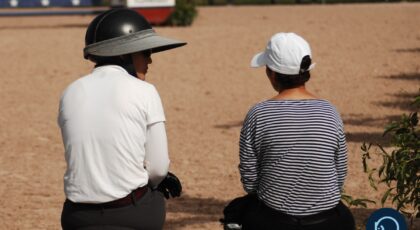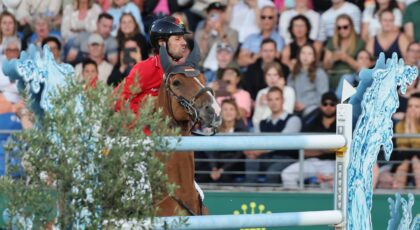As a new recruit for Major League Show Jumping’s Trailblazers team this season, California native Emma Marlowe looks right at home among towering grand prix tracks in North America’s most prestigious venues. But as the ambitious 24-year-old explains, her success at this elite level of showjumping was never guaranteed. As told to Carley Sparks and Nina Fedrizzi.
My story is a little different than most Grand Prix riders.
I didn’t get to do the North American Youth Championships. I didn’t compete on junior jumper teams. I didn’t even ride my first jumper class until I was 18.
Up until six years ago, I was an equitation rider. Almost exclusively. And in California. Exclusively.
Now I ride for Team Trailblazers on the CSI5* Major League Show Jumping tour and compete all over Canada, the United States and Mexico. Crazy, right?
But here’s the thing. I always believed I’d get here…
I’m from California. I grew up doing the circuit out there as a working student for Leslie Steele at Acres West. Leslie really took me under her wing. She was the first person who believed in me and she, along with David Bustillos and Pam Stewart, gave me unbelievable opportunities as a junior rider. I wouldn’t be where I am today if it wasn’t for everything they did for me.
A big part of that was access to quality horses and instruction. Working for Leslie, I did a lot of catch riding in the hunters and equitation divisions.
At the time, it felt like a big step up.
Before Leslie, I rode backyard horses. Literally. My mom ran a lesson barn and kept horses in our backyard. My sister and I rode whatever we had. It was a lot of free lease horses and off-the-track Thoroughbreds. Often they were difficult horses, but it never scared me.
Looking back, I think that was a unique way to be introduced to the sport. Eventually, when I did start competing—sometimes on horses I didn’t know well—those early skills and the courage I developed definitely helped me.
Because, I’ve never really felt any fear. Even when I finally started jumping 1.40m at age 20, I always believed in myself. I just had so much desire, and so much ambition, to do it that it kind of overrides everything else.
Like, I’ll die trying every time. I will never give up.
I’m just oddly kind of brave. And good at forgetting when something doesn’t go my way. When I have a rail or make a miscalculation, I’m immediately thinking about what has to happen at the next.
That goes for being on the back of a horse, and also when it comes to talking my way into a room. When people tell me “no,” I’m kind of like, “Yeah, but I think if you just meet me, and you see how much I want it, and how hard I will work for it, you’ll give me a chance.”
It’s how I got my chance to ride jumpers in the first place.
In 2017, I got a wild card spot in the USEF Horsemastership Clinic in Wellington, Florida and it was through that opportunity that I met American Olympian Lauren Hough. After the clinic, I reached out to Lauren about working for her. (I figured the worst she could say was no.)
Lauren wasn’t looking for help at the time, but she is very good friends with U.S. team member Cara Raether Carey and passed my number along.
And Cara actually called me back!
I distinctly remember being on that phone call. In my mind, it didn’t matter what Cara said, or what the job entailed. I’d already made up my mind that I was going to go. Fortunately for me, she took a chance on an 18-year-old from California who’d never jumped above 1.20m before, and hired me as a working student for Trelawny Farms.
Looking back at it now, it seems pretty crazy.
I didn’t know Cara at all. I didn’t know Trelawny. I’d never really left California before.

Cara took a risk on me and I think, at the end of the day, it paid off for both of us.
In the last six years, Cara has taught me more things than I have space to write. She’s been around the world, and jumped countless Nations Cups. She medalled at the Pan American Games. She has done it all and has this amazing feel on a horse. So often, training that feel is difficult for top riders. It’s hard for them to explain what they’re feeling, because it’s all so natural to them. Cara is a very natural rider, but she’s also able to explain what she’s feeling to me, it’s incredible.
Having someone like that believe in you does amazing things for your skills and your confidence. And, for my part, I really want to learn.
I spend hours listening to Cara and watching her ride. I feel like I know her so well at this point that I can just look at her and know what she’s thinking. I study training videos from other top riders that I admire. I learn from the grooms in the barn. It’s a testament to Cara that most of the grooms at Trelawny have been there for over 10 years. They’re the best in the world and are making me a better horsewoman.
I just have so much desire to learn every part of this sport.
The goal, of course, is for all those lessons to carry over in the jumper ring. Getting to that point from where I started, though, has been an uphill battle.
There was a huge learning curve after all those years doing the hunters and equitation. In hunters, it’s often a much softer ride on a longer rein. When I got into the jumpers, the horses needed a lot more support, a lot more dressage work, and a lot more leg-to-hand contact. The tempo and the rhythm to the jumps also makes it a much different sport.
It wasn’t what I was used to, but it’s coming easier now.

If you said to Cara five years ago that she and I would be riding on a CSI5* Major League Show Jumping team together, I don’t think she would have believed it. Even now, I’m kind of shocked how far we’ve come together—how far she’s taken me.
Because every time I walk into a big class, it’s kind of my first time doing it.
I was 22 when I competed in my first CSI2* Grand Prix. I’m 24 now and just this year, I did my first 1.50m class. So you could definitely say I’ve been playing catch up along the way.
And there are times when I definitely feel it. Like when I did my first U-25 Grand Prix at Spruce Meadows, I remember thinking, This could be the Olympics. These are the biggest jumps I’ve ever seen. But my next thought is almost always, I’ll just give it a try and do my best.
Now, there are some big classes when I’ll look up after a clear round and I’m overjoyed that I’m competing amongst the best in the world. I’m like, How did that just happen?
I know one of the big reasons, aside for Cara, is my horse, Cherokee. He’s a 15-year-old KWPN gelding owned by Cara and Trelawny Farm, and he’s taught me so much. Cara herself showed him at a high level, and she graciously let me start competing him a couple of years ago. It’s incredible to go in, and get experience on a horse like that. I truly believe he can do anything, and he’s made me believe in myself as well.
He is the most intelligent horse, too. He has these beautiful brown eyes. When you’re standing at the in-gate, he’ll watch the horse in front of you, and I swear he’s learning the course and figuring it out, because he absolutely loves doing it.
He also love to nip, so there’s that. He’s earned his nickname, “Cheeky.” He’s always trying to bite you, but for sure, he knows how much I love him. I think that makes him try harder for me.
And I’m starting to figure it out.
I won my first 1.40m on Cheeky at HITS Saugerties a few years ago, and I jumped my first CSI3* Grand Prix on him, as well as my first CSI5* classes.

With any sport, you’re constantly trying to improve. Currently, I’m focused on my jump offs. I’m still inexperienced in jump-offs, especially at international height. So often I’ll think I’m going fast—and I am—but I’m also going so wide that I’m really not going fast at all. Paul O’Shea, who is also a trainer and mentor to me and Cara (and an incredible rider!), has really helped me with training tighter turns and it’s starting to pay-off.
Last June, in the jump-off for the CSIO5* 1.50m class at Thunderbird Show Park, we went the fastest I’ve ever gone in my life and ended up fourth. Cheeky was amazing. It was the first time I felt like I rode a big jump-off course correctly and competitively. It was such a great feeling! It motivates you to keep chasing your dreams, to keep improving.
Because even though I’ve come so far, there’s still so much further I want to go. I want to ride for the USA. I want to be on Nations Cup teams. And compete in championships. I want to train and develop horses to the highest level. I have big goals—and I’m just getting started.
When I look at my career so far, I think the advice I would give to others is just to believe in yourself. That goes for people with big dreams, even if they don’t have the resources to achieve them. If you’re willing to work hard and put yourself out there and come from a really genuine place, there are people in this sport who will help you.
That’s what Cara and Trelawny have done for me. I just needed to take the first step.
Six years ago, I was an equitation rider that got on a plane and took a risk. Now I compete in CSI5* shows on a MLSJ team. Anything is possible.


 November 19, 2022
November 19, 2022 

























